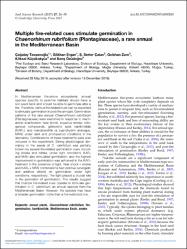Multiple fire-related cues stimulate germination in Chaenorhinum rubrifolium (Plantaginaceae), a rare annual in the Mediterranean Basin

View/
Date
2017Author
Tavşanoğlu, ÇağatayErgan, Gökhan
Çatav, S. Serter
Zare, Golshan
Küçükakyüz, Köksal
Özüdoğru, Barış
Metadata
Show full item recordAbstract
In Mediterranean fire-prone ecosystems, annual species specific to post-fire habitats should have a soil seed bank and should be able to germinate after a fire. Therefore, various fire-related cues can be expected to stimulate germination in post-fire annuals. Germination patterns of the rare annual Chaenorhinum rubrifolium (Plantaginaceae) were examined in response to mechanical scarification, heat shock, aqueous smoke, nitrogenous compounds, gibberellic acid, karrikinolide (KAR(1)), and mandelonitrile (a cyanohydrin analogue, MAN) under dark and photoperiod conditions in the laboratory. Combinations of these treatments were also included in the experiment. Strong physiological dormancy in the seeds of C. rubrifolium was partially broken by several fire-related germination cues, including smoke and nitrate, under light conditions. KAR(1) and MAN also stimulated germination, and the highest improvement in germination was achieved in the KAR(1) treatment in the presence of light. Heat shock + smoke and KAR(1) + MAN combinations had positive synergetic and additive effects on germination under light conditions, respectively. The light played a crucial role in the promotion of germination. The results suggest that multiple fire-related cues operate to stimulate germination in C. rubrifolium, an annual species from the Mediterranean Basin. However, the species may have a broader germination niche than a fire-restricted one.

















